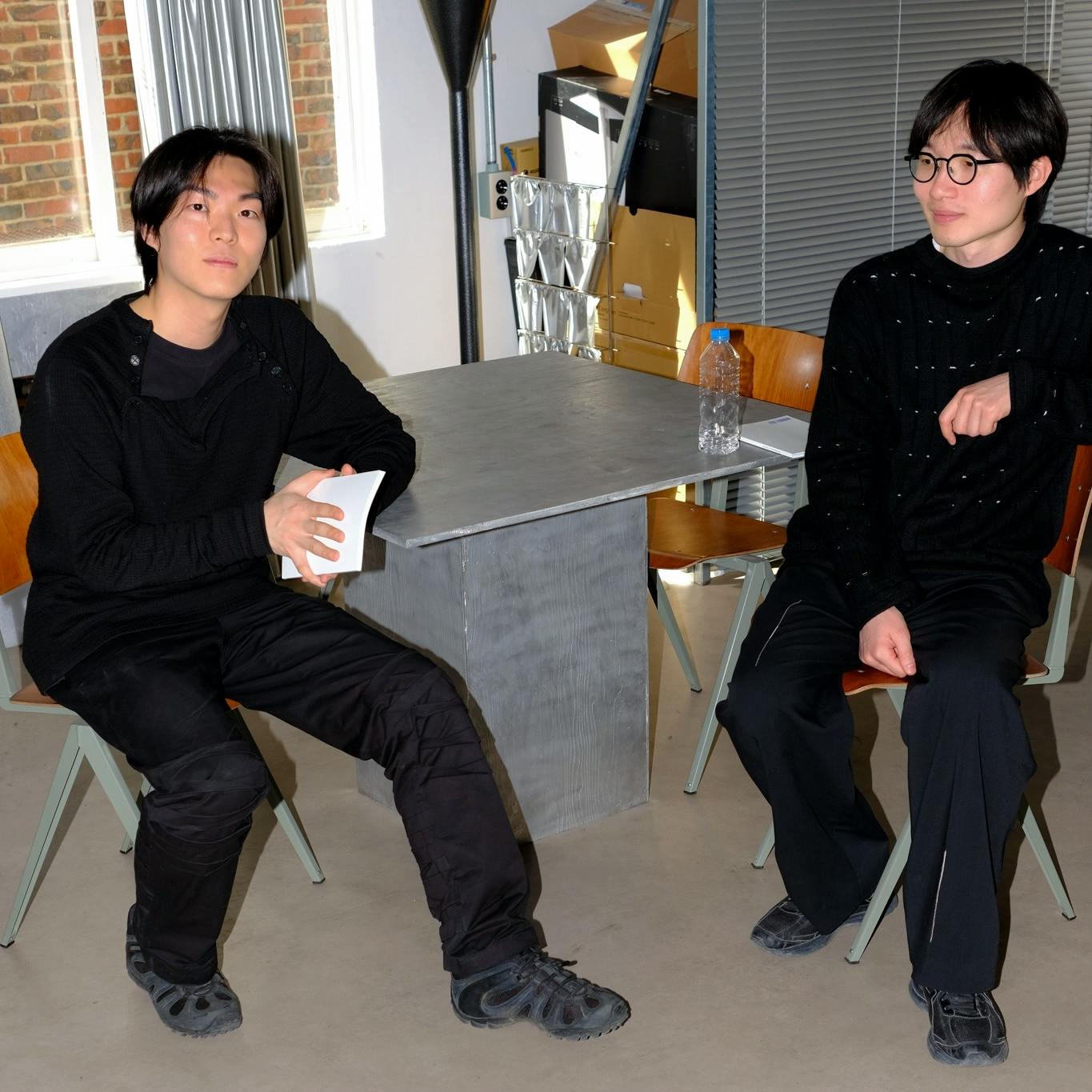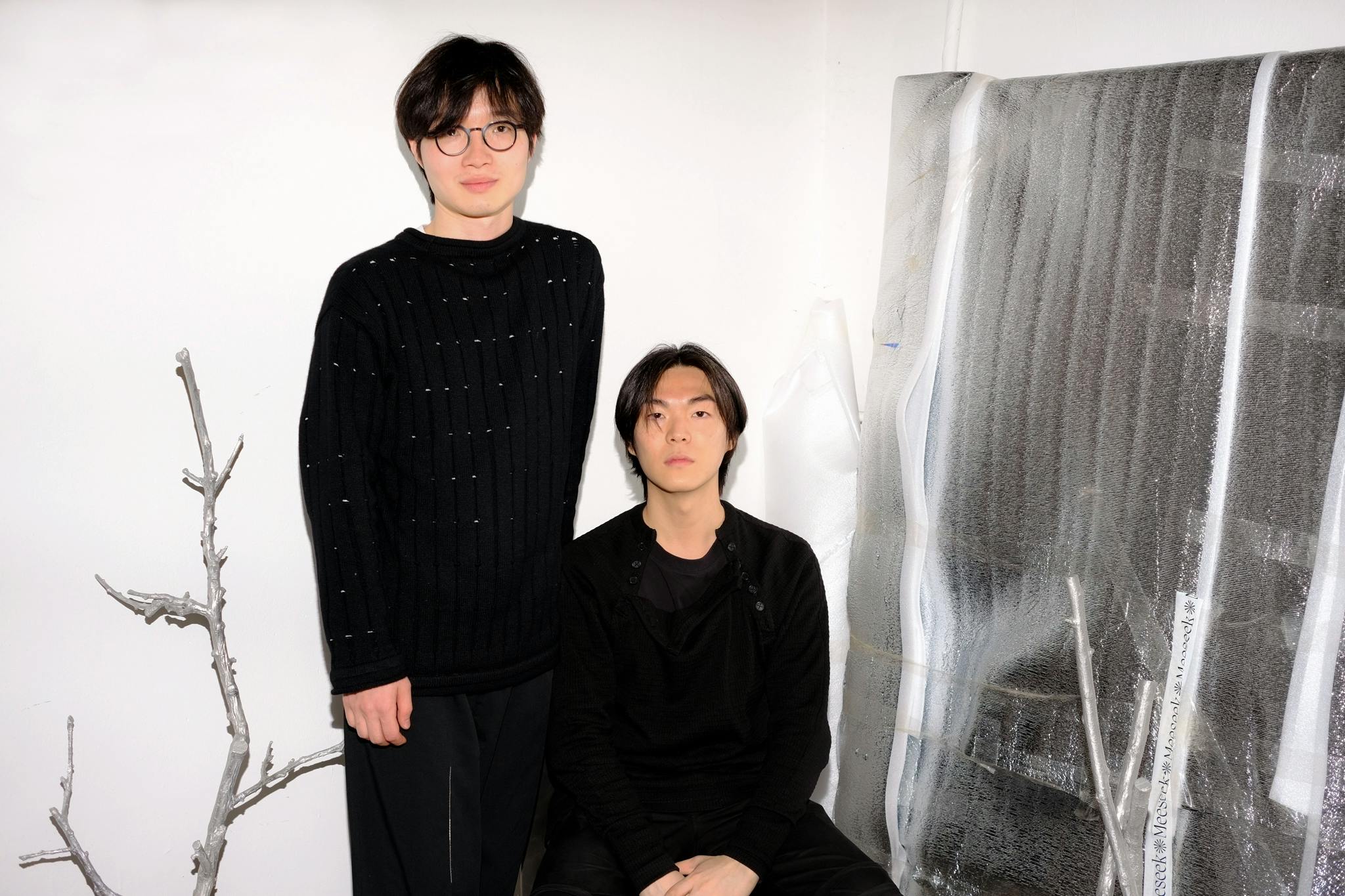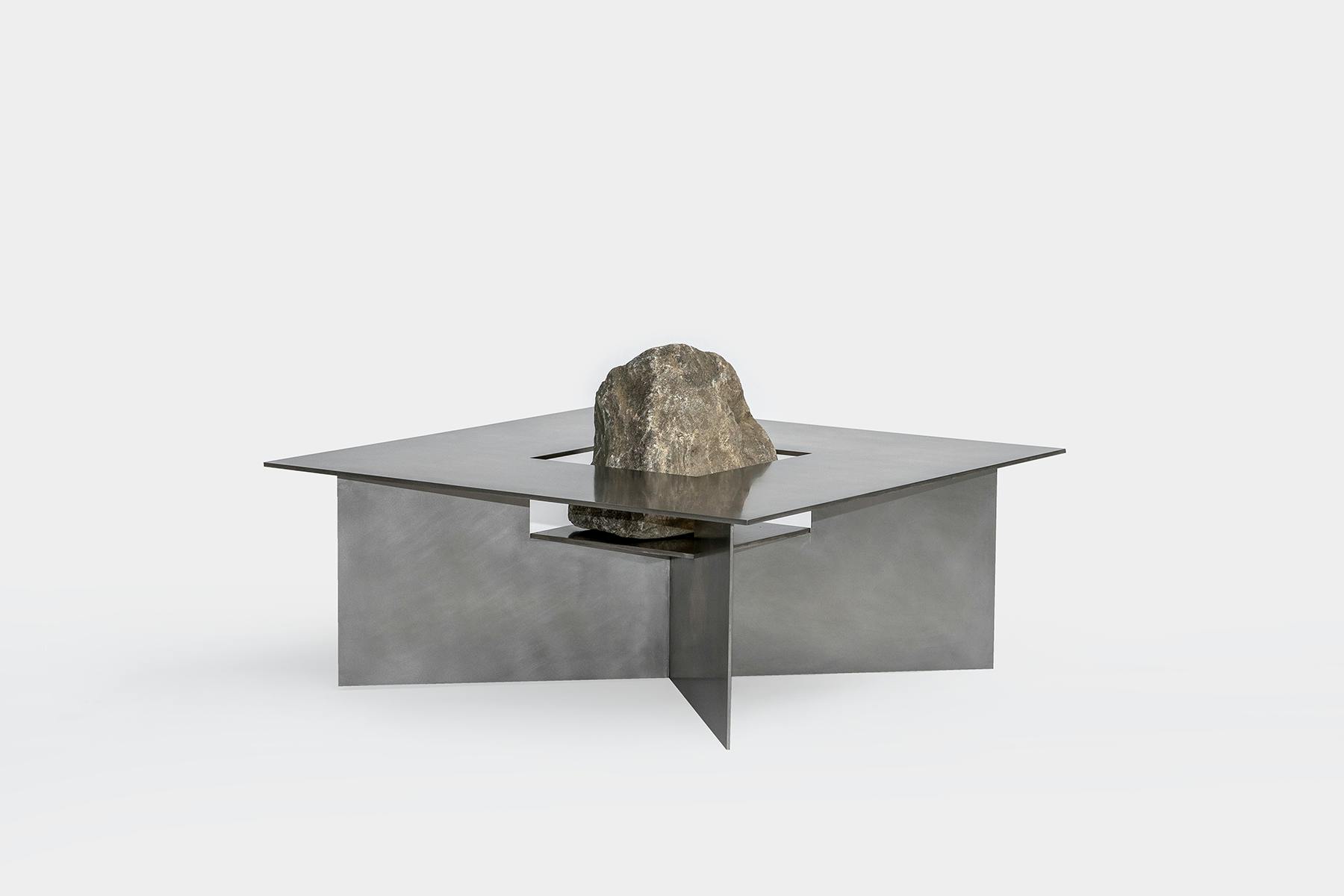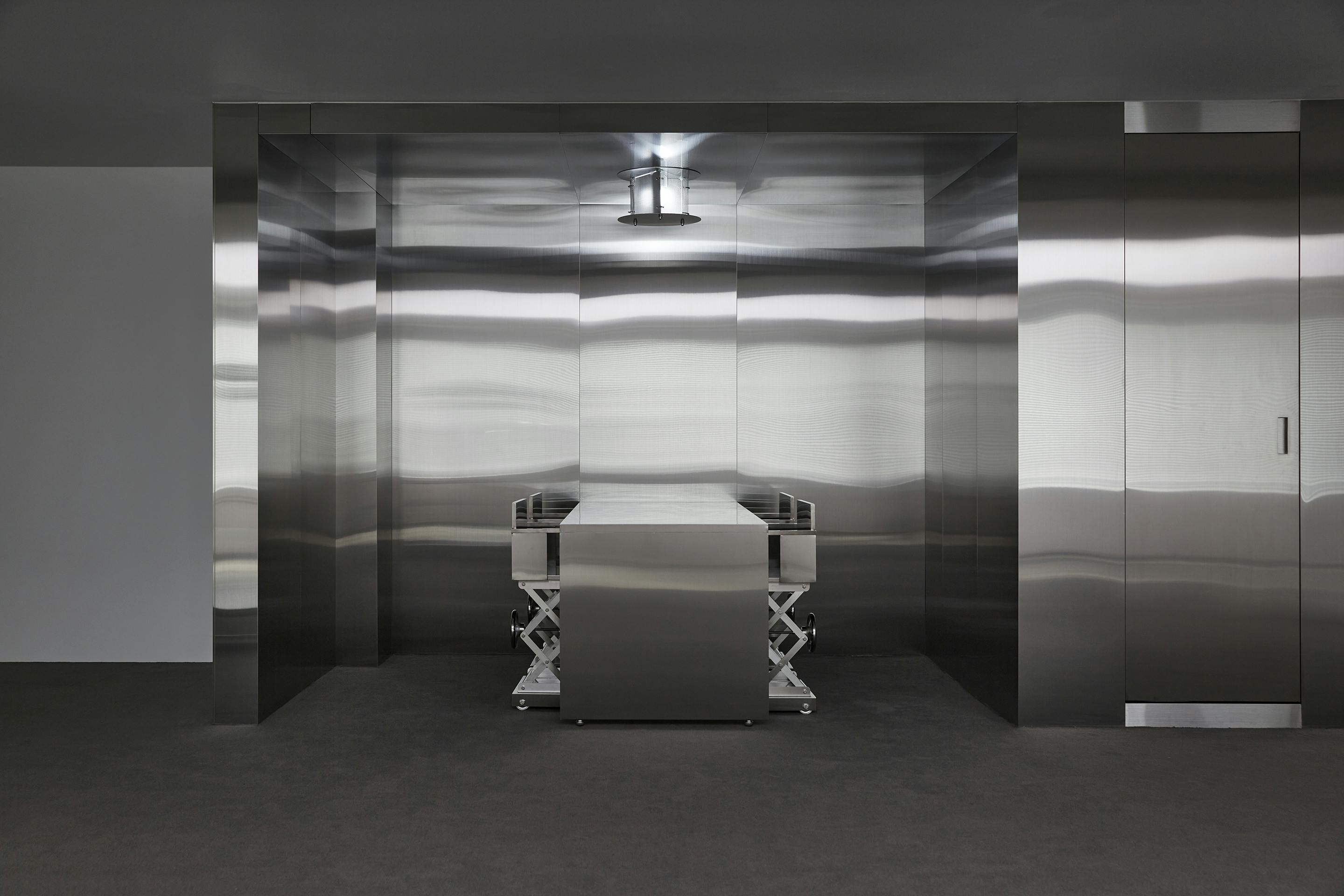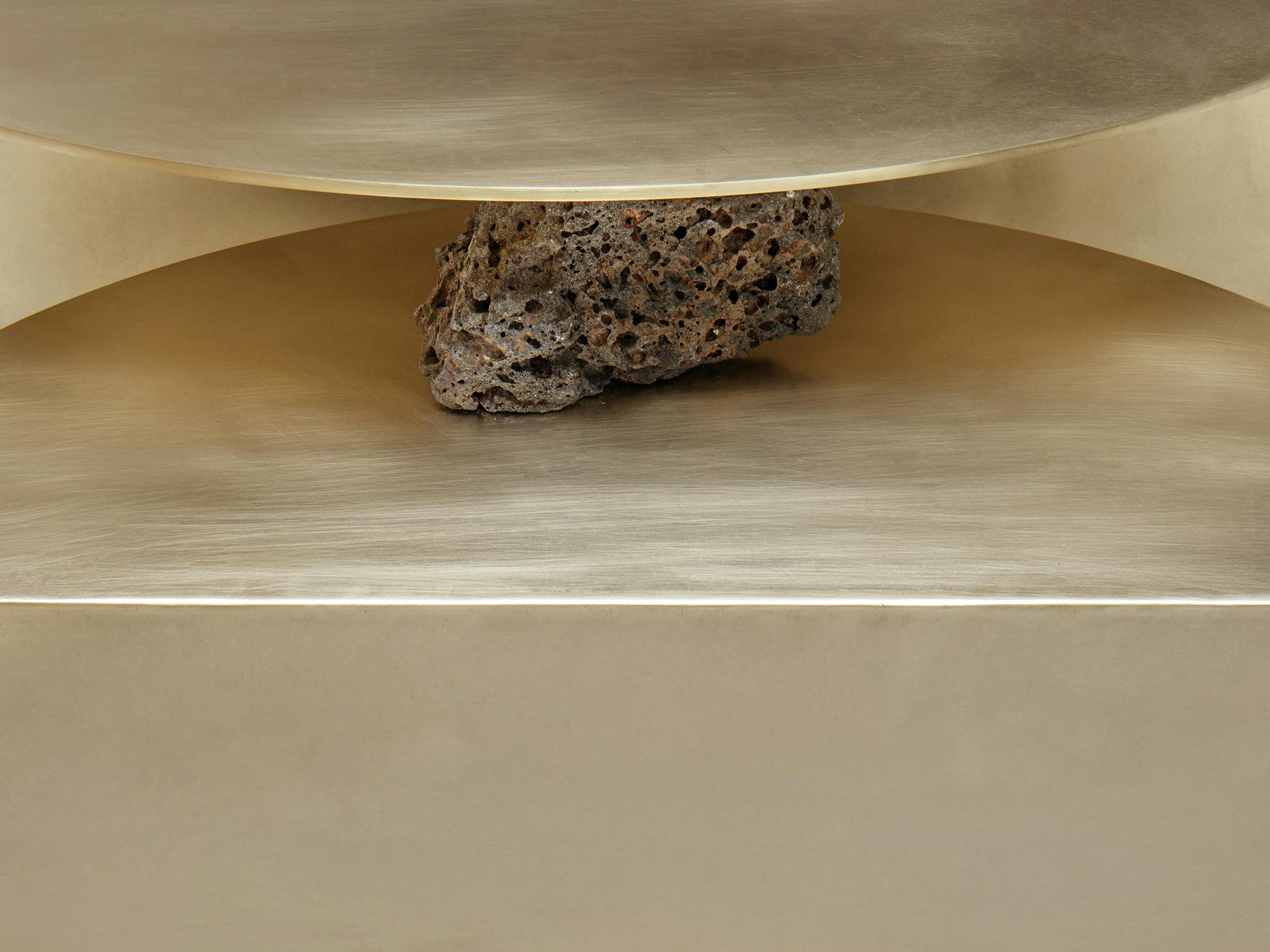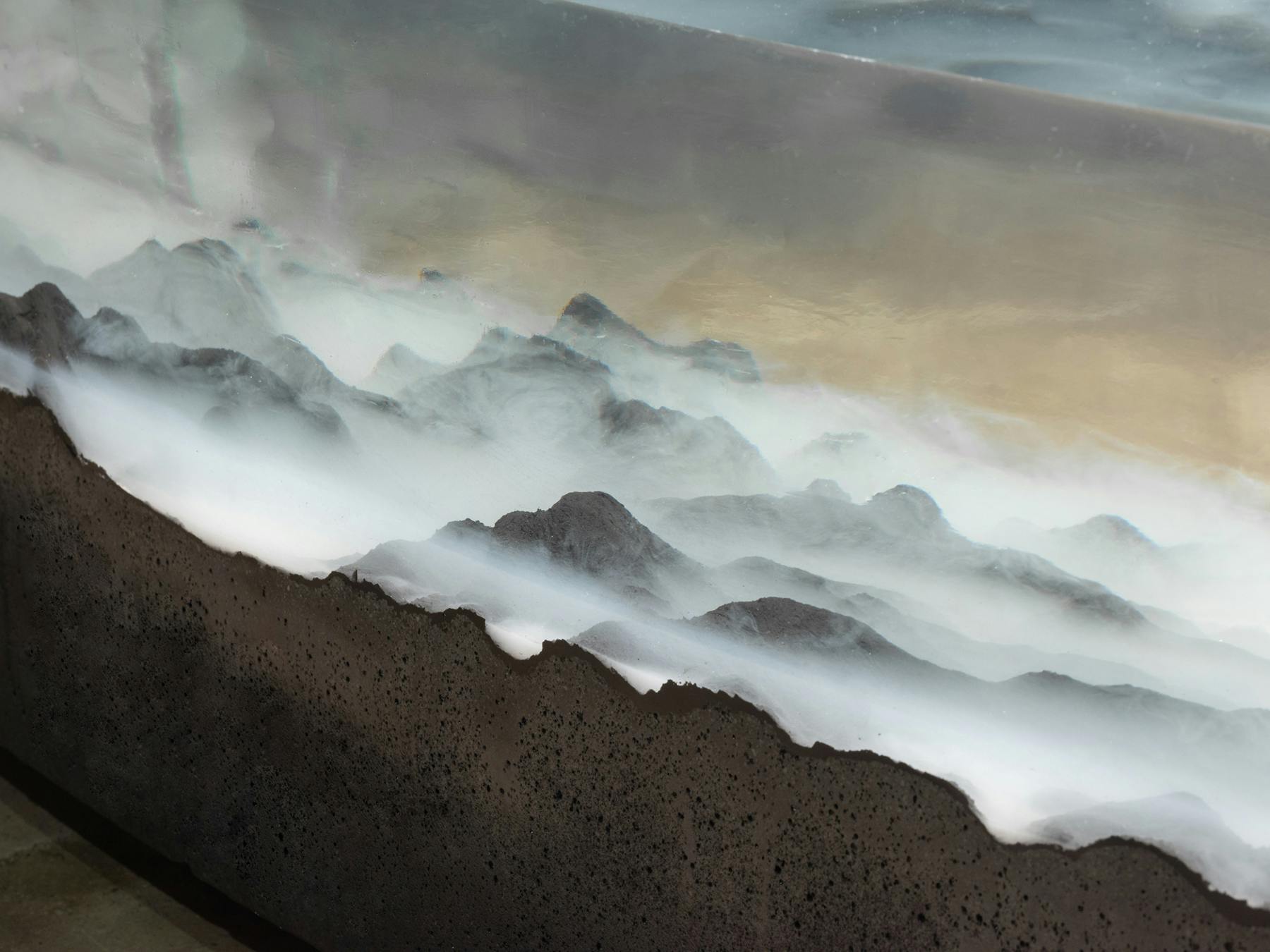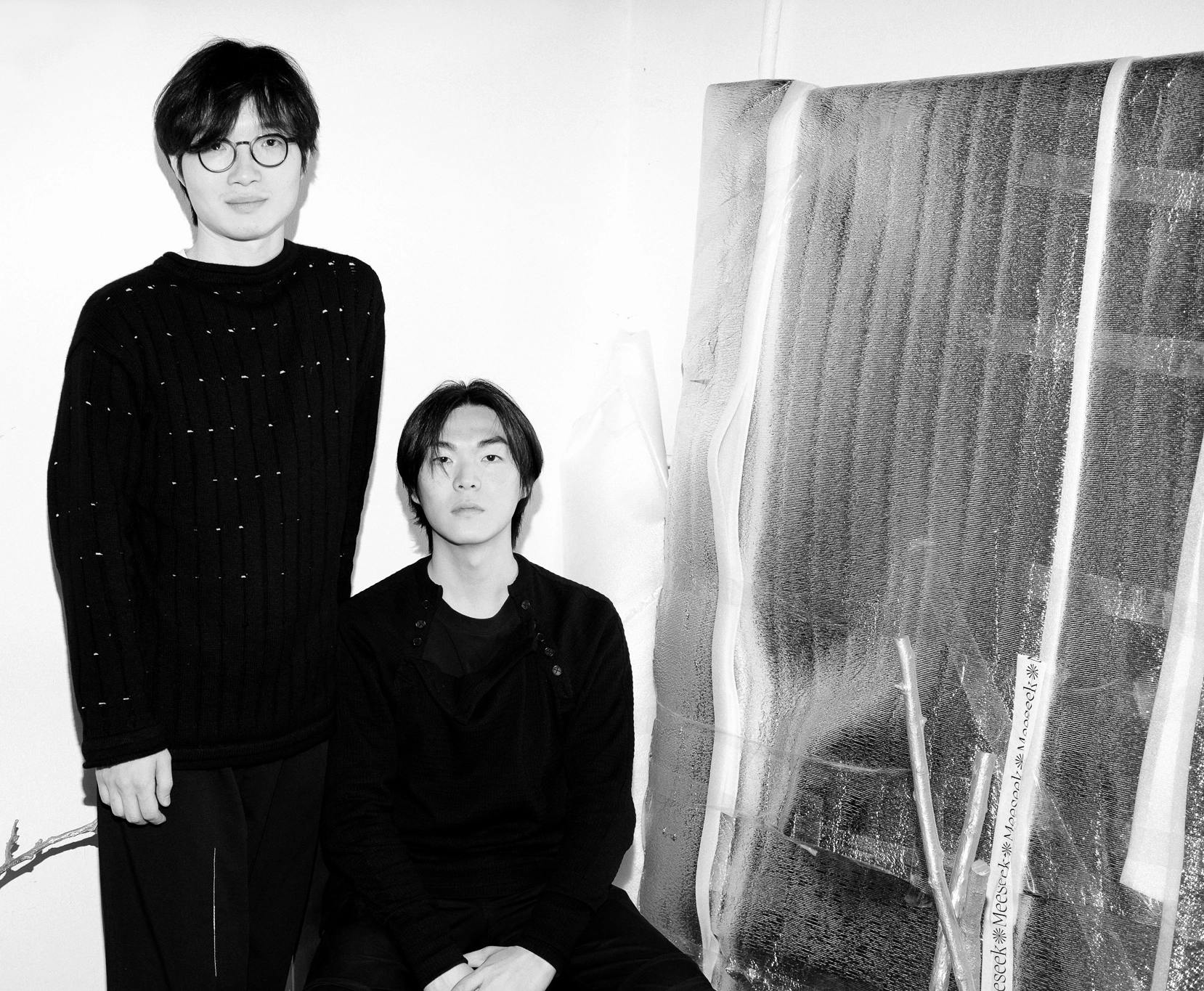
Practice – Sisan Lee and Seohu Ahn
We visit furniture and space designer duo Sisan Lee and Seohu Ahn of PRACTICE in their Seoul Office
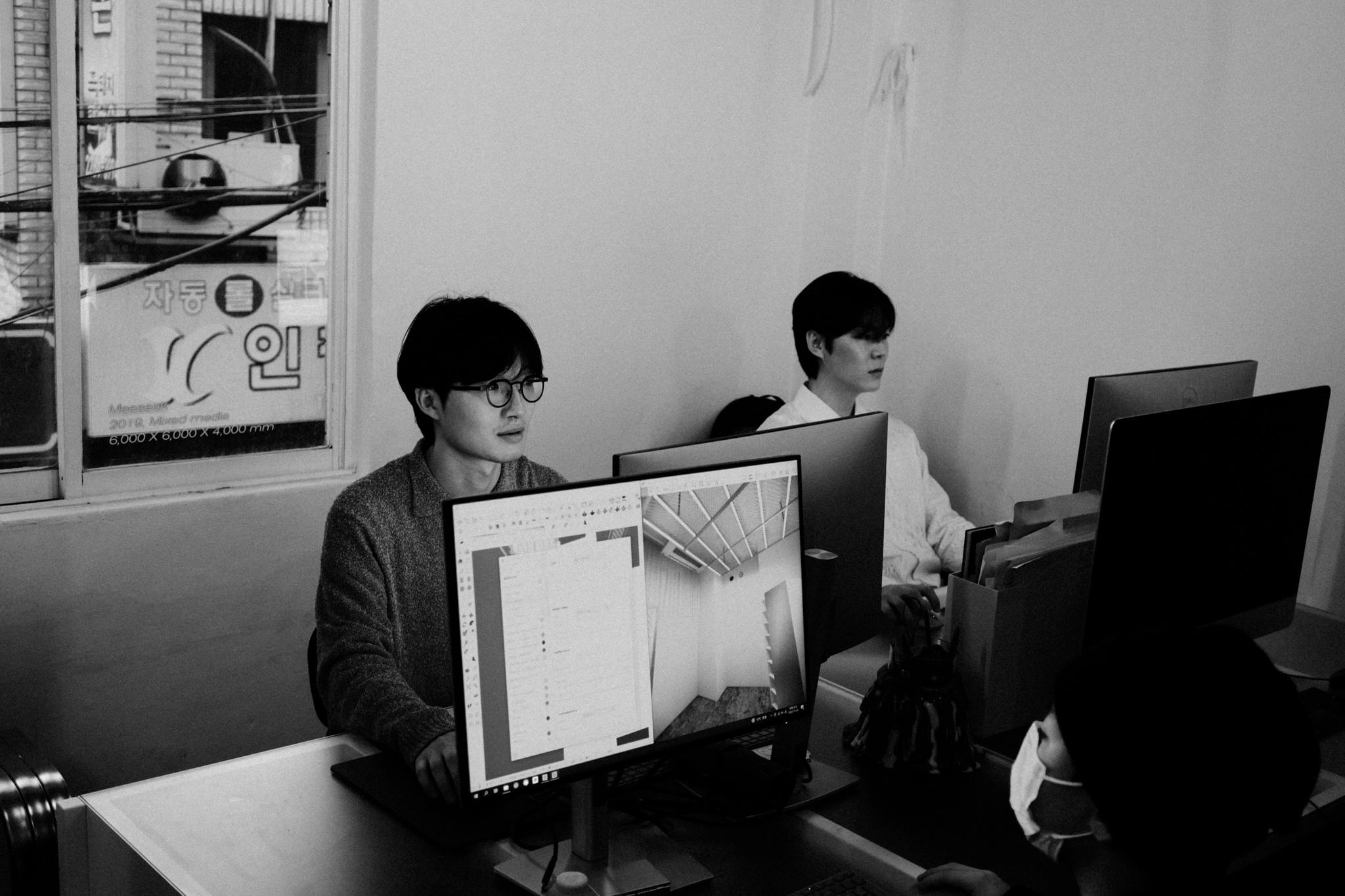
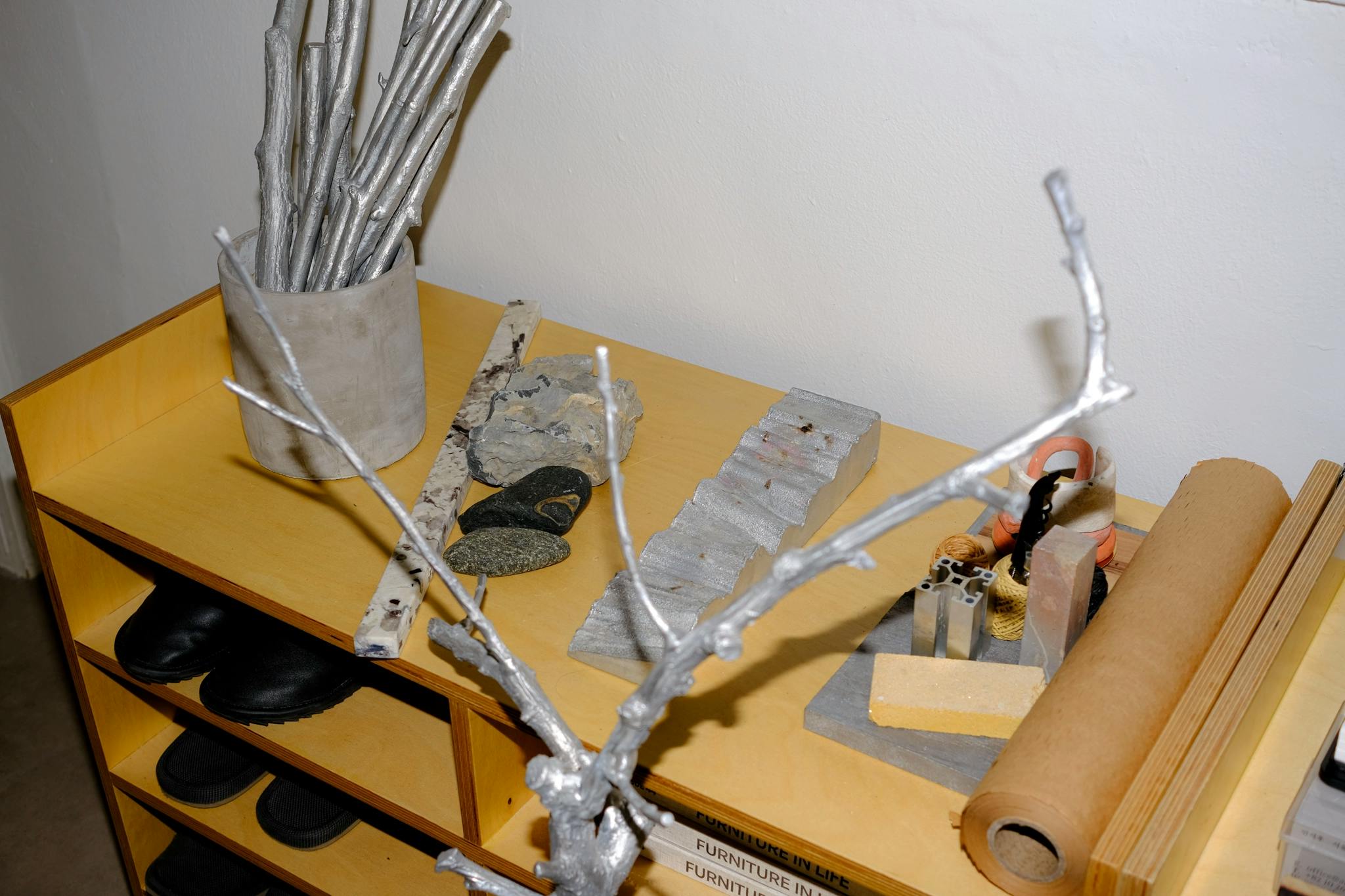
Kristen de la Vallière_ Let’s start at the beginning. How did you both get started in furniture and design?
Sisan Lee_ I went to Konkuk University, which is located in Chungju City and studied Interior design. While studying interior design and doing projects in school, I had doubts about all the virtual spaces and images I made without knowing how it is actually built.
So then I took a furniture class where I had the opportunity to actually make something and try to sit on them in real life. Those were enjoyable experiences for me, so I made furniture as a hobby along with school projects.
Then there was one rendered image I posted on Instagram, where the curatorial platform, Meeseek, contacted me. Back then, I only had a rendered image of a shelf where stones and stainless steel plates were stacked, but Meeseek invited me to participate in the exhibition. So that is how I got a chance to make physical furniture in real life.
충주에서 학교 건국대학교에서 인테리어를 전공을 했어요. 인테리어 프로젝트를 학교 과제로 하다 보니까 뭔가 실제로 만들어지지 않은 것 가상에 대한 어떤 의구심, 이게 어떻게 지어지고, 어떻게 만들어지는 것들을 배우지 못한 것에 대해 의구심이 들었어요.
그래서 가구 수업을 들었고, 실제로 만들어보고 직접 앉아보고 하는 것들이 너무 재미있는 경험이어서, 학교 다닐 때 가구를 만드는 일을 취미로 학교 수업과 병행했어요.
그때 모델링 3d 이미지로 렌더링을 돌려서 인스타에 올렸었는데 그걸 이제 미식에서 보고 연락이 왔어요. 돌이랑 철판이 쌓여져있는 선반의 형태가 렌더링 이미지로만 있었는데 미식에서 전시요청이 온거에요. 그래서 실물로 작품을 만들 수 있는 기회가 되었죠.
How did you figure out how to make it in real life?
Sisan_ I interned at an interior design studio for four weeks while in school. During my internship, I met this metal factory owner and wood maker who were very friendly to me, and they would say, “Come visit the factory” or “If you have any questions, ask us,” so I got a lot of help from them.
학교 다니면서 4주간 인테리어 회사에 인턴 생활 할 수 있는 기회가 있었어요. 그때 만났던 금속 공장 사장님이랑 목공하시는 분이 저를 되게 좋게 봐주셔서 "공장 놀러 와라" "모르는 거 있으면 물어봐라" 해서 도움을 많이 받았어요.
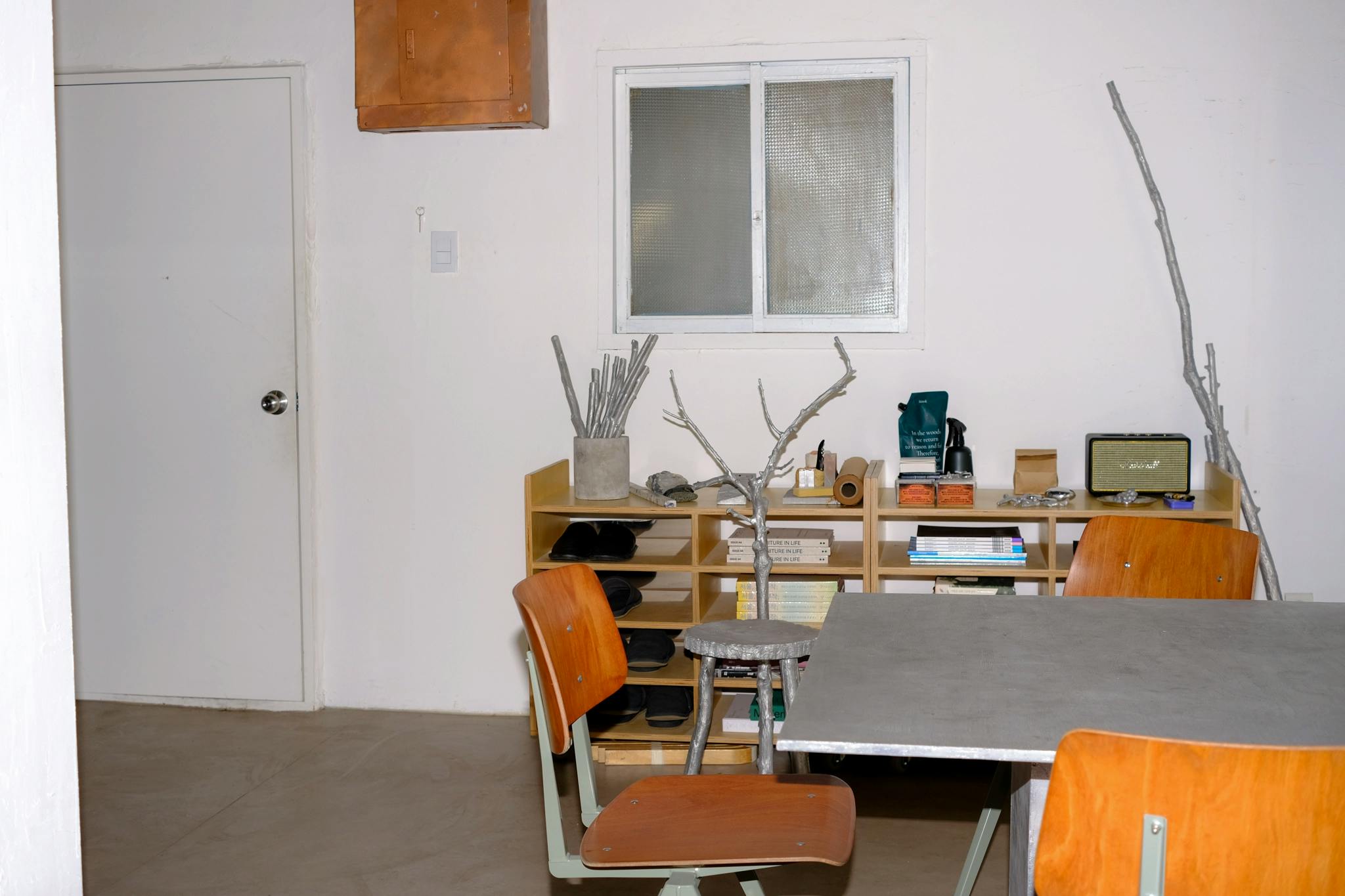
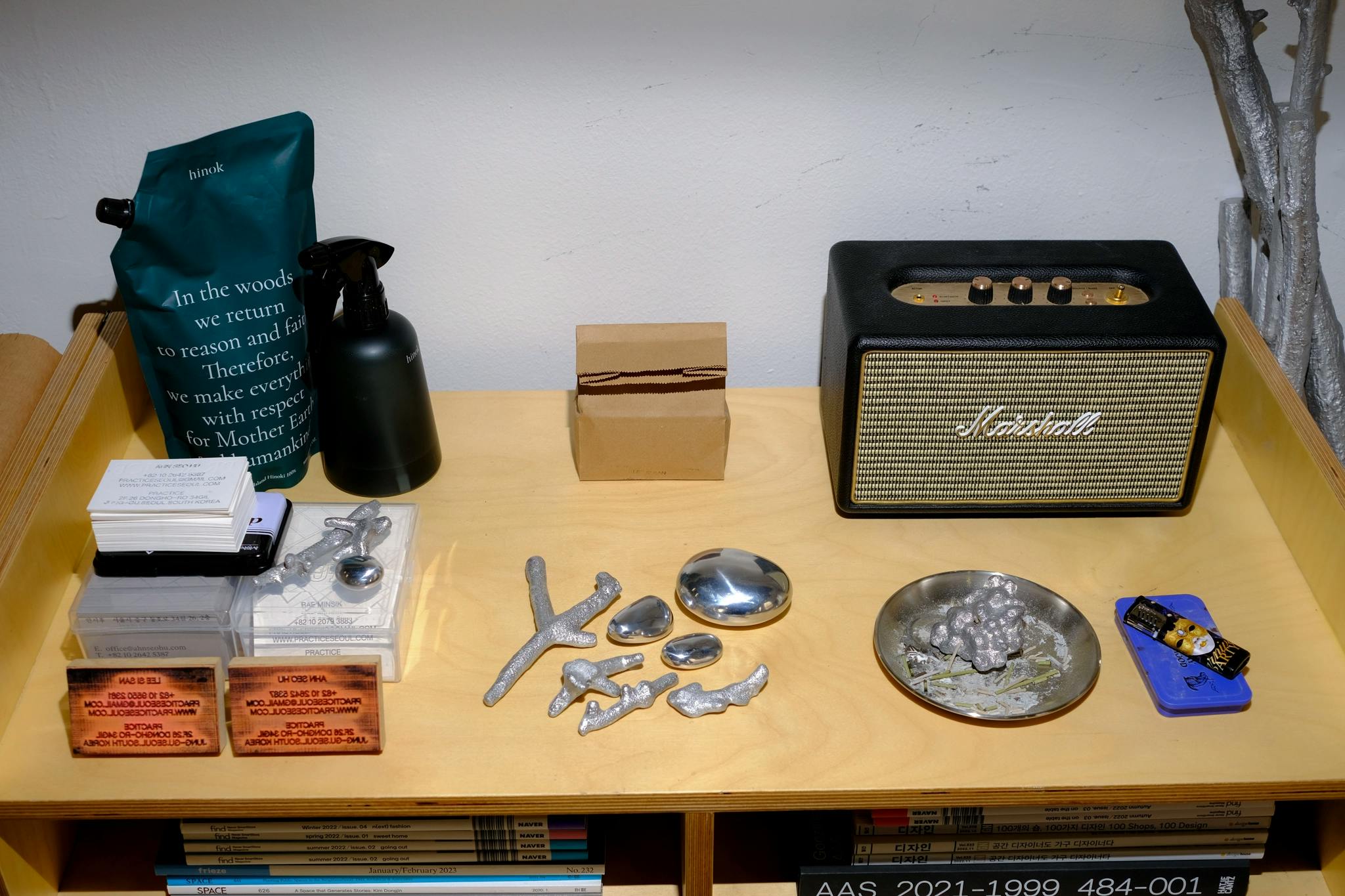
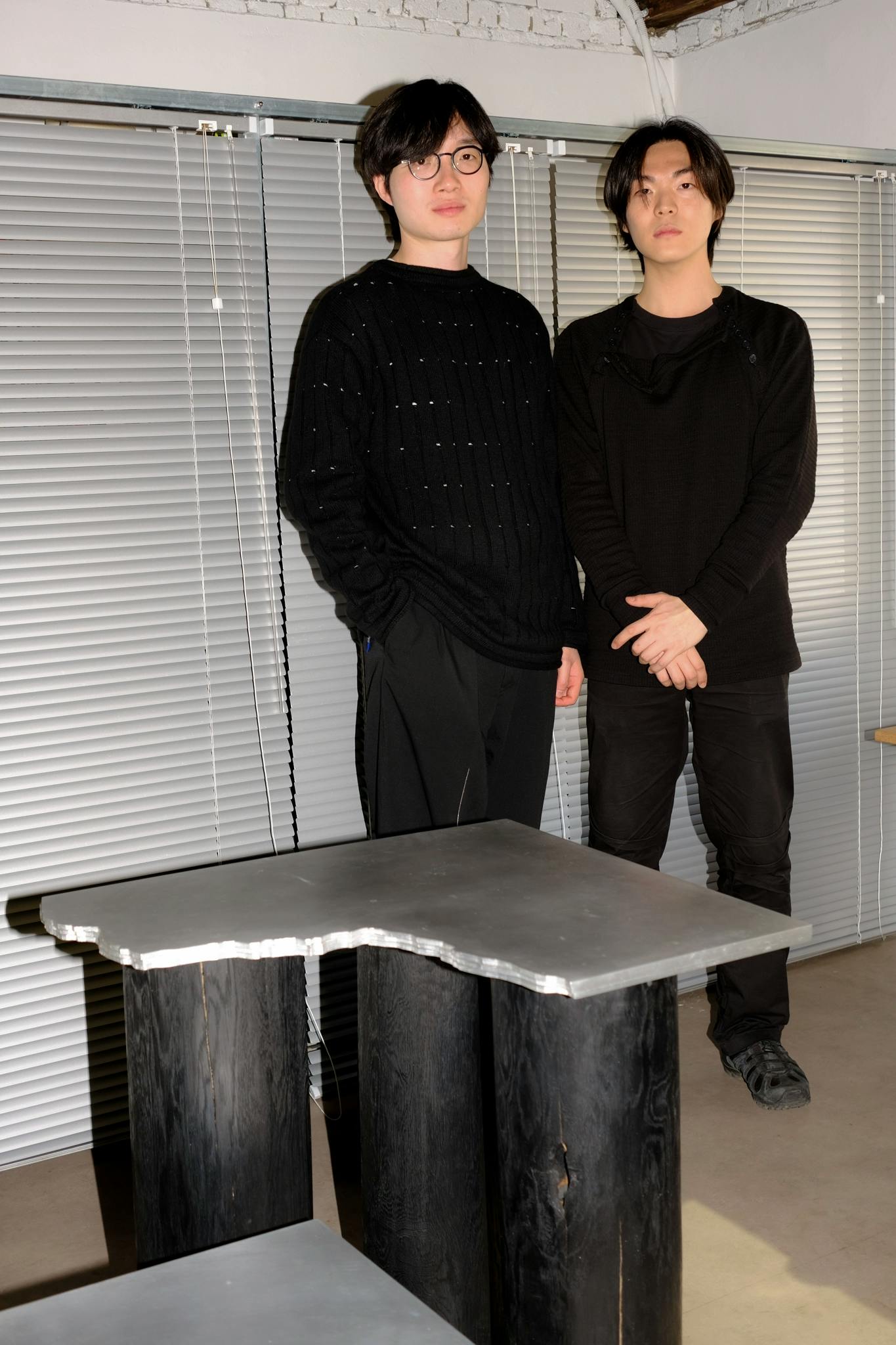
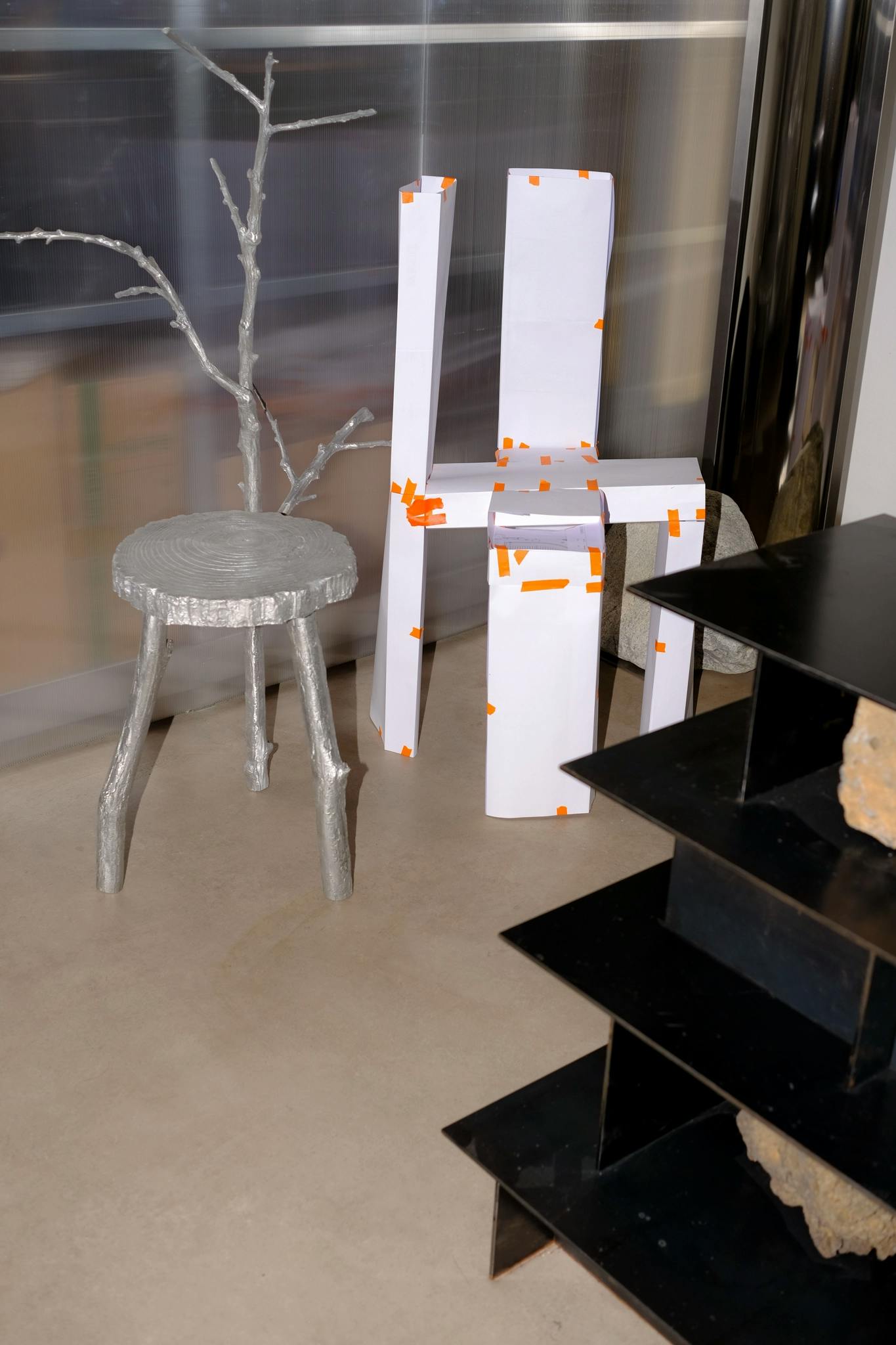
Seohu Ahn_ I studied Architecture at University, and after graduation, I was really interested in furniture because architects also make furniture, and sometimes they put their message into their pieces. Around the time I graduated, I saw a lot of artists on Instagram who work with furniture, and I wanted to get to know them and do something together. But there were few chances or platforms to do that, so I decided to make one myself.
Then I found and rented this place and started to find artists who could exhibit here, such as Sisan, Jinyeong Yeon, and Oneseo Choi. That’s how I started Meeseek. Back then, I just wanted to get to know them rather than address important messages as a gallery.
저는 건축을 전공했고, 대학을 졸업하고 가구에 관심이 많았어요. 건축가들은 가구를 항상 좋아하고 자기 건축 메시지를 전달할 때 가구를 사용하니까요. 그때쯤에 인스타그램에서 가구 작업을 하는 작가들을 보게되었고, 저 사람들이랑 같이 뭔가를 해보고, 친하게 지내고 싶었어요. 근데 그럴 만한 기회가 많이 없었어요. 그래서 내가 이 기회의 장을 만들어야겠다고 결심했어요.
이제 여기를 찾아서 계약을 하고, 전시할 작가들을 인스타그램으로 찾기 시작을 했는데 그때 이시산, 연진영, 최현서 작가님을 만나게 되었어요. 그렇게 자연스럽게 미식을 시작했고, 갤러리처럼 중요한 메세지를 던지기 위해서라기 보다는 그냥 이렇게 알고 싶어서 시작한거죠.
What did you see Meeseek being? Did you envisage it as a curatorial platform or a place where people can meet, make new pieces?
Seohu_ I wanted to continue those relationships, so I thought it would be better to do an exhibition in order to exchange ideas and make something happen together rather than just to meet and chat.
그냥 만나기만 하는 건 의미가 없으니까, 전시같은걸 하며 작업적으로 교류하고 같이 뭔가를 만들어가고 싶다고 생각했어요.
Do you mind me asking from one curator to another, is that's something where you able to get funding, or is that something you had to pay yourself?
Seohu_ At first, I had to invest my own money to run this place, so I sold tea here. I made an audience to see the exhibition while having tea. This year I did a lot of exhibitions with government funding, but I always think about the same issue, too. Recently I got an investor, so I am preparing something new.
처음에는 이제 전시 공간만 운영을 하려면 제 사비를 계속 써야 했으니까 여기서 차를 팔았어요. 차를 마시며 작품을 감상할 수 있게 했죠. 올해는 나라에서 지원을 받아 전시기획을 많이 했어요. 최근에는 투자를 받아서 뭔가 새로운 걸 또 준비를 하고 있어요.
Was that hard to find investors? How do you approach that as a curator to get funding or investors?
Seohu_ Part of it is a coincidence. I met someone who can sell this furniture to collectors. So he invested and asked me to help him to sell pieces.
우연적이기도 했어요. 가구를 팔아줄 수 있는 사람을 만났거든요. 그래서 그분이 투자를 하고, 도와서 작품을 팔 수 있도록 이야기한 상황이에요.
What did your business look like at the beginning?
Sisan_ After I made my first series, I received some contact from magazines, so I got the confidence to continue to make more collections. I expanded my breadth of work and made more series of about ten pieces. While doing that, some corporations, like Lotte, Hyundai, etc., contacted me. Lotte department store Myeong-dong has my piece as a permanent collection, and when The Hyundai Seoul opened recently, they asked me to collaborate with them.
So after selling to those big commercial spaces I was able to reinvest in my work and make this new series with aluminum cast branches.
처음에 무위 시리즈를 하고 여러 매거진 쪽에서 연락이 왔어요. 그래서 자신이 좀 생겨서 계속 컬렉션을 만들게 된 거죠. 이 시리즈를 확장을 시켜서 거의 열 몇 개의 시리즈를 만들었어요. 근데 그걸 하다 보니까 이제 롯데, 현대 같은 기업 쪽에서 연락이 왔어요. 롯데백화점 명동점에 가면 제 작품이 영구적으로 전시가 되어있고, 또 현대백화점 더 현대서울을 오픈한다고 했을 때 또 콜라보를 하게 되었죠.
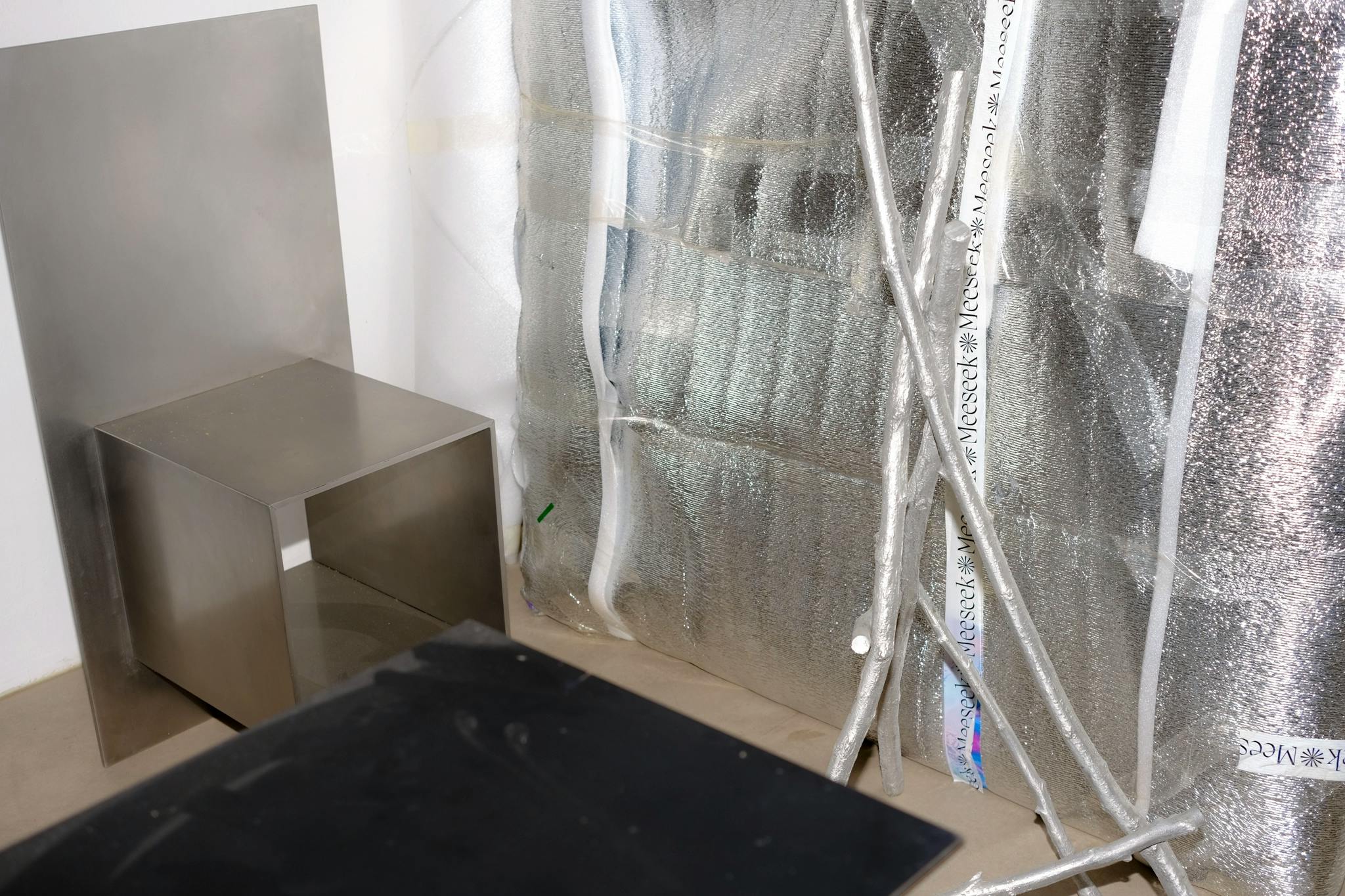
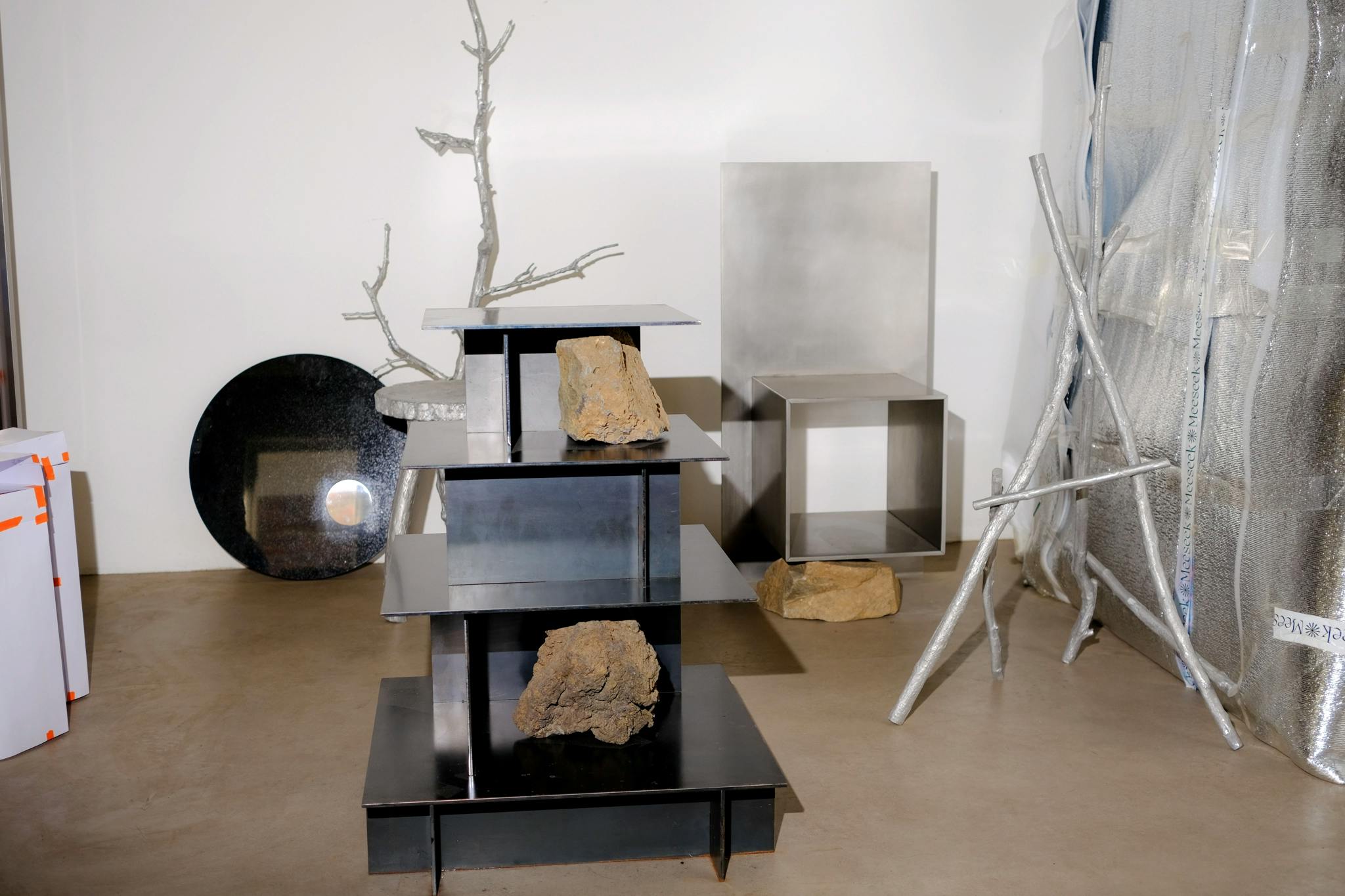
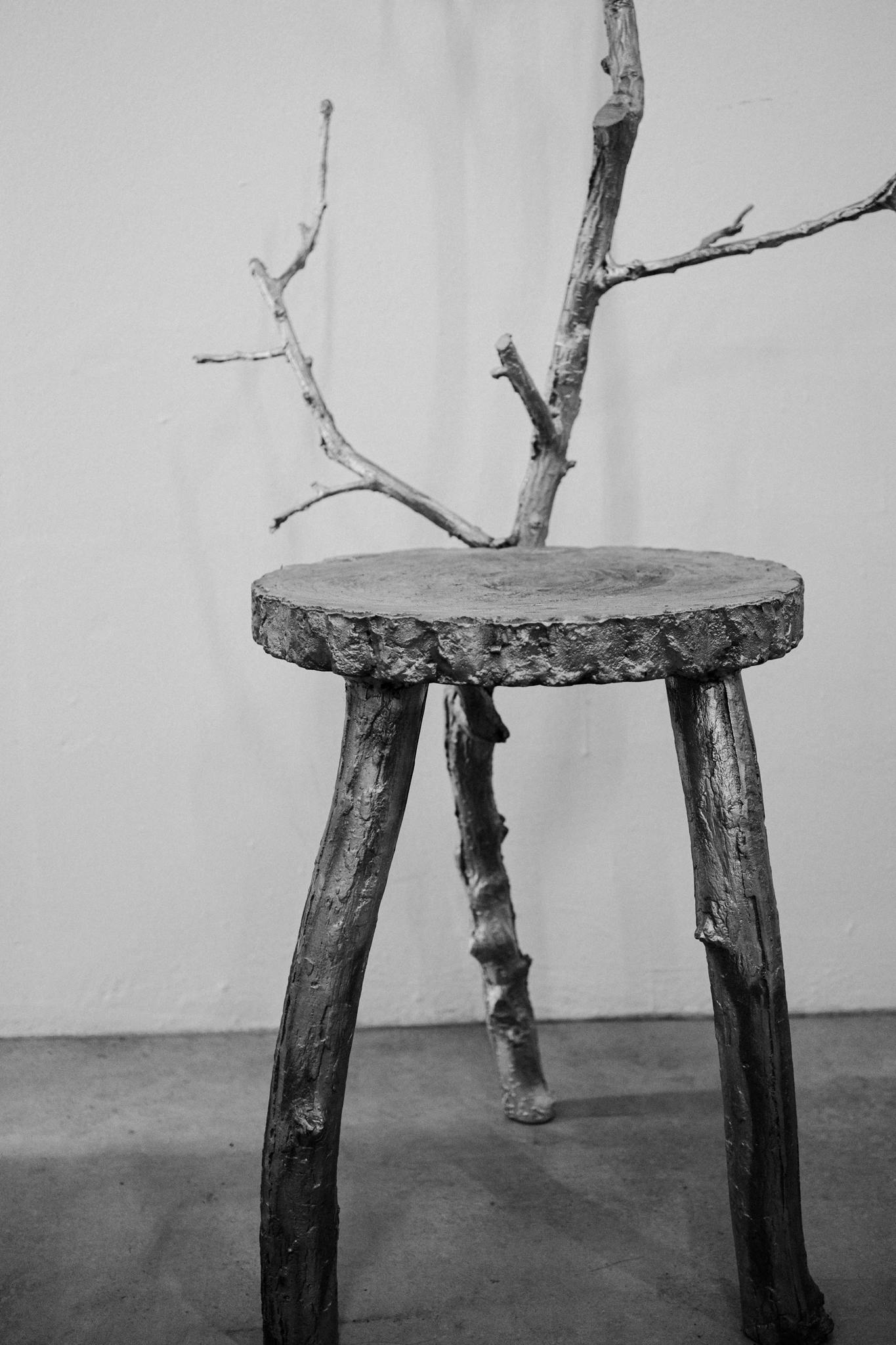
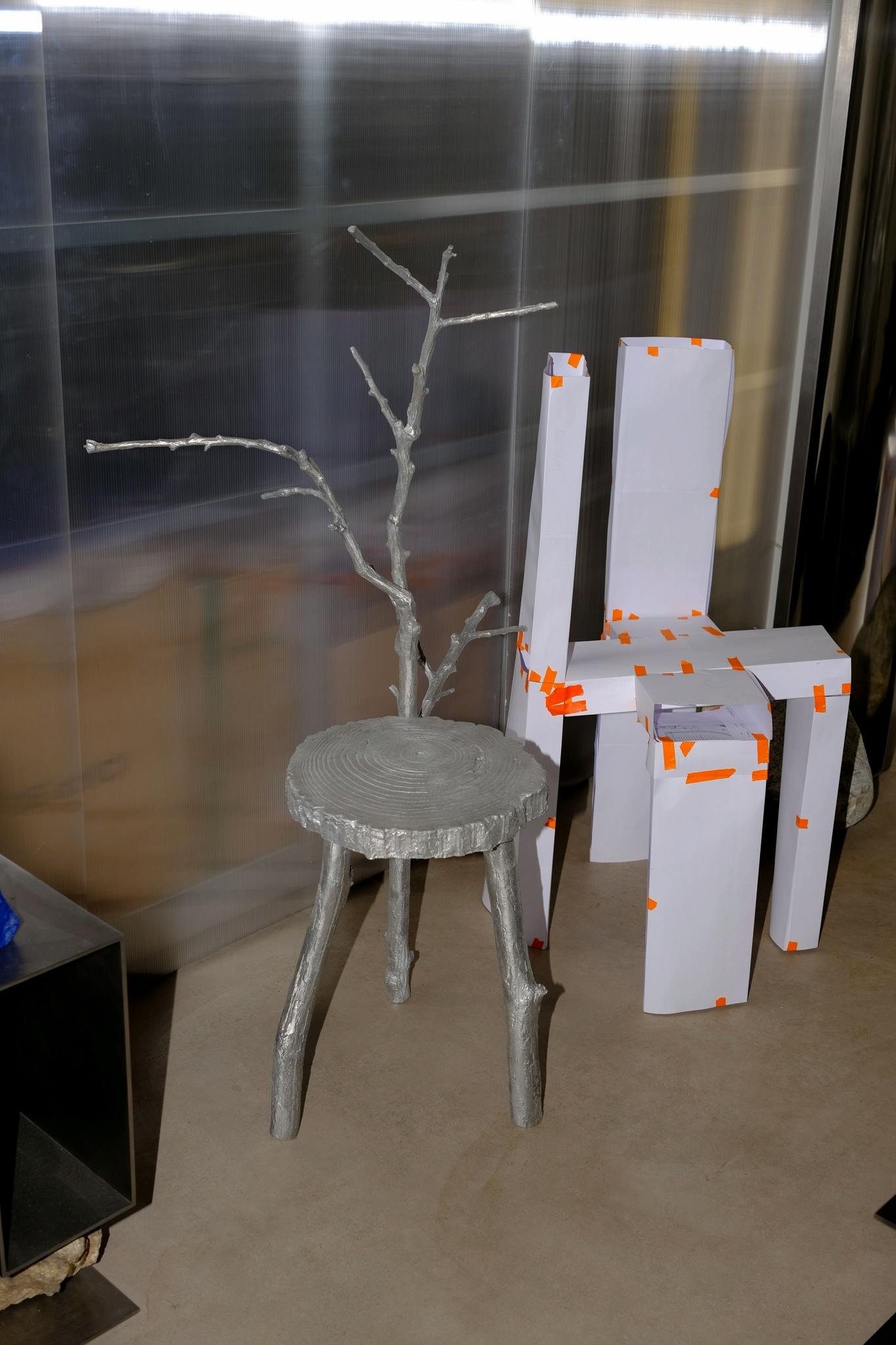
In Korea, even if designers are working with maybe more artificial or less natural materials, it seems as though there's always some connection to nature in one way or another. Is that something historic? Something linked with Korean design identity?
Sisan_ I don't know if that is the Korean design identity, but for me, it is more connected to my environment, which is closer to nature. I really liked that and wanted to utilise it for my work. I think using natural elements in one’s work makes each piece unique — because nothing is the same in nature.
저는 그게 한국적인지 잘 모르겠어요. 근데 저의 경우에는 있었던 지역적인 특성 자체가 자연과 접할 수 있었고, 그 기운이 너무 좋아서 작품에 쓰고 싶었어요. 자연의 요소를 사용하는게 유니크피스가 된다고 생각을 하거든요. 자연물이라는 건 똑같은 게 존재할 수 없으니까요.
Seohu_ I think Seoul is a very rare city having four or five mountains within the actual city — so there are many opportunities to see or experience the natural environment. I heard no other metropolis in the world has a big mountain inside the city like this.
서울은 도시 안에 4~5개의 산이 있는 매우 드문 도시라고 생각해요. 그래서 자연 환경을 보거나 경험할 기회가 많고요. 세계의 다른 어떤 대도시도 도시 안에 이렇게 큰 산을 가지고 있지는 않다고 들었어요.
Sisan_ I also want to add that for me; the city environment is also a part of nature. Sometimes when I encounter nature in an artificial environment, I get a very good vibe.
Everything is mixed, such as artificial lakes. Sometimes nature is surrounded by the city, or if you look at the city from the top of the mountain, it looks like it is surrounded by nature. So for me, nature is not the only inspiration, but this combination of natural and artificial, I try to mix both of them, which, in my opinion, is closer to our daily life.
덧붙여 말하자면, 저는 도시의 환경도 하나의 자연 같은 느낌이 들어요. 이런 인공적인 어떤 환경에서 가끔 자연물을 봤을 때 되게 좋은 기운이 오거든요.
모든게 되게 섞여 있는 것 같아요. 인공 호수처럼. 도시 안에 자연이 있을 수도 있고 또 산 정상에 올라가서 보면 자연 안에 도시가 있고요. 저는 자연만이 저의 영감은 아닌 것 같아요. 자연과 인공을 섞으려고 해요. 그게 일상적이니까요.
What is the name of the creative practice you launched together?
Seohu_ Our practice is called Practice.
우리의 연습은 Practice에요.
Sisan_ We didn’t start Practice Seoul from the beginning, but Ahn had one project, which was to design the gallery called Alterside.
He knew I could also do interior design, so he asked me to do this project together. However, we found out that we needed business registration so we just did it. We didn’t have huge ambitions, but after the first project, people started approaching us with small projects.
For example, there was one painter who visited Meeseek once. She wanted to purchase my work, so we were having a conversation, and then she asked us if we could design her studio. So that became our second project .At some points, my and Seohu’s practice met and overlapped, which became the opportunity for Practice Seoul to start.
처음부터 Practice Seoul을 하자고는 시작한건 아니에요. 안 실장님한테 Alterside라는 갤러리를 디자인해달라는 프로젝트가 하나 있었어요.
제가 인테리어를 하는 걸 알고 프로젝트를 함께하자고 제안했죠. 그런데 사업자가 필요했고, 그래서 그냥 빨리 Practice를 만들었어요. 그때는 뭔가 거창하게 장기적인 목표를 가지고 할 생각은 없었는데 첫 프로젝트 이후에 계속 조그만한 일들이 계속 들어왔어요.
예를 들어서 미식을 방문했던 회화 작가님 제 작품을 또 구입하시고 싶다고 하셨고, 이야기를 나누다가 작업실을 의뢰하고 싶다고 하셔서 그게 두 번째 프로젝트가 되었고요. 안 실장님과 저의 어떤 접점 사이에서 일어나는 사건들에 의해서 프레티스가 많은 프로젝트를 할수있는 기회가 됐던 것 같아요
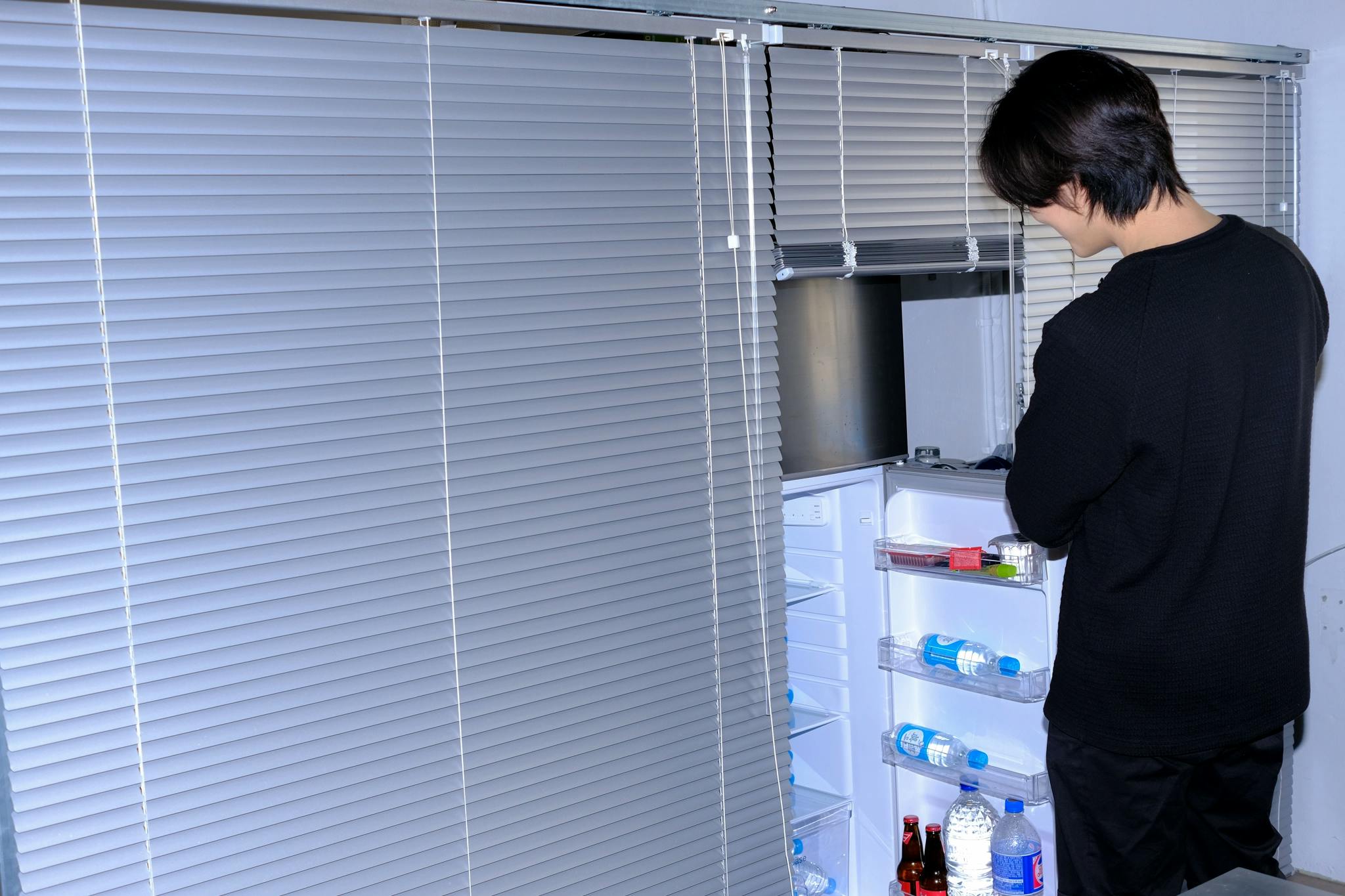
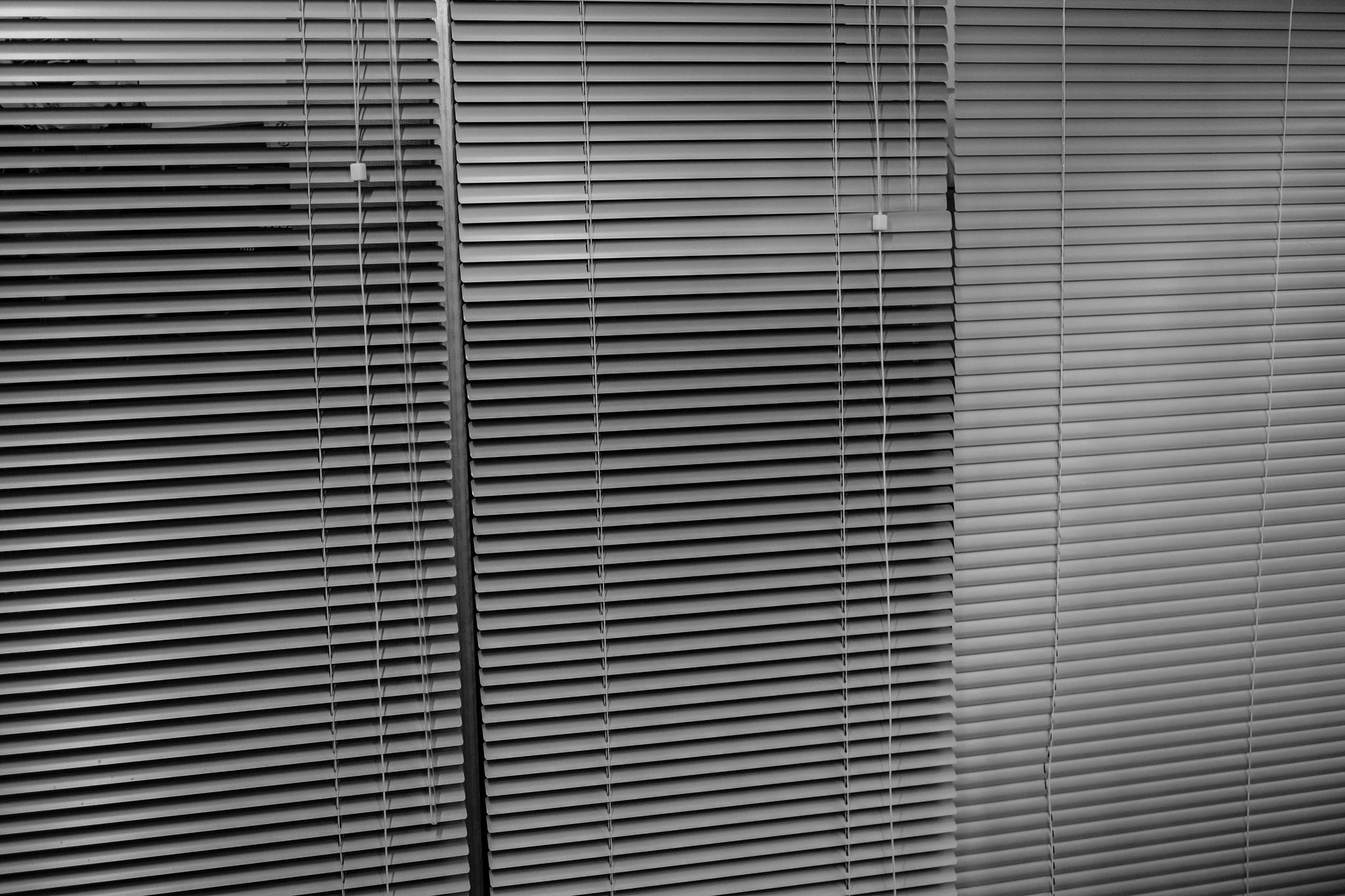
You've worked with a few big brands in the last few years, namely Rimowa. Can you tell us a little bit about how these type of partnerships come about and what the creative exchange looks like to bring those collaborations to life?
Sisan_ For Rimowa, Marin, their partnerships director found me on Instagram and suggested collaborating with Rimowa. There were some conditions, such as using symbolic features of Rimowa. They sent the list of parts of their bag like wheels, handles etc.
I tried to mix those symbols and natural features from my work, so I used an aluminium sheet for the chair. And in terms of the structure, I used aluminium casted tree branches. They trusted me in the process of communication and respected my identity.
리모와는 Marin이라는 친구가 인스타그램으로 저를 찾았나 봐요. 그래서 콜라보 하자고 메일로 왔었고요. 리모와의 상징적인 특징들을 사용해야한다는 조건들이 있었어요. 그래서 부품 리스트를 보내줬는데 거기에는 바퀴, 손잡이등이 있었죠.
저는 자연물이랑 이걸 섞는 방식을 시도했었고, 그래서 알루미늄 시트를 의자 안장으로 사용했어요. 그리고 나머지 구조적인 부분에는 알루미늄 캐스팅 한 저 나뭇가지 썼고요. 커뮤니케이션 하는 과정에서 저를 많이 믿어줬고, 저의 아이덴티티도 존중해줬어요.
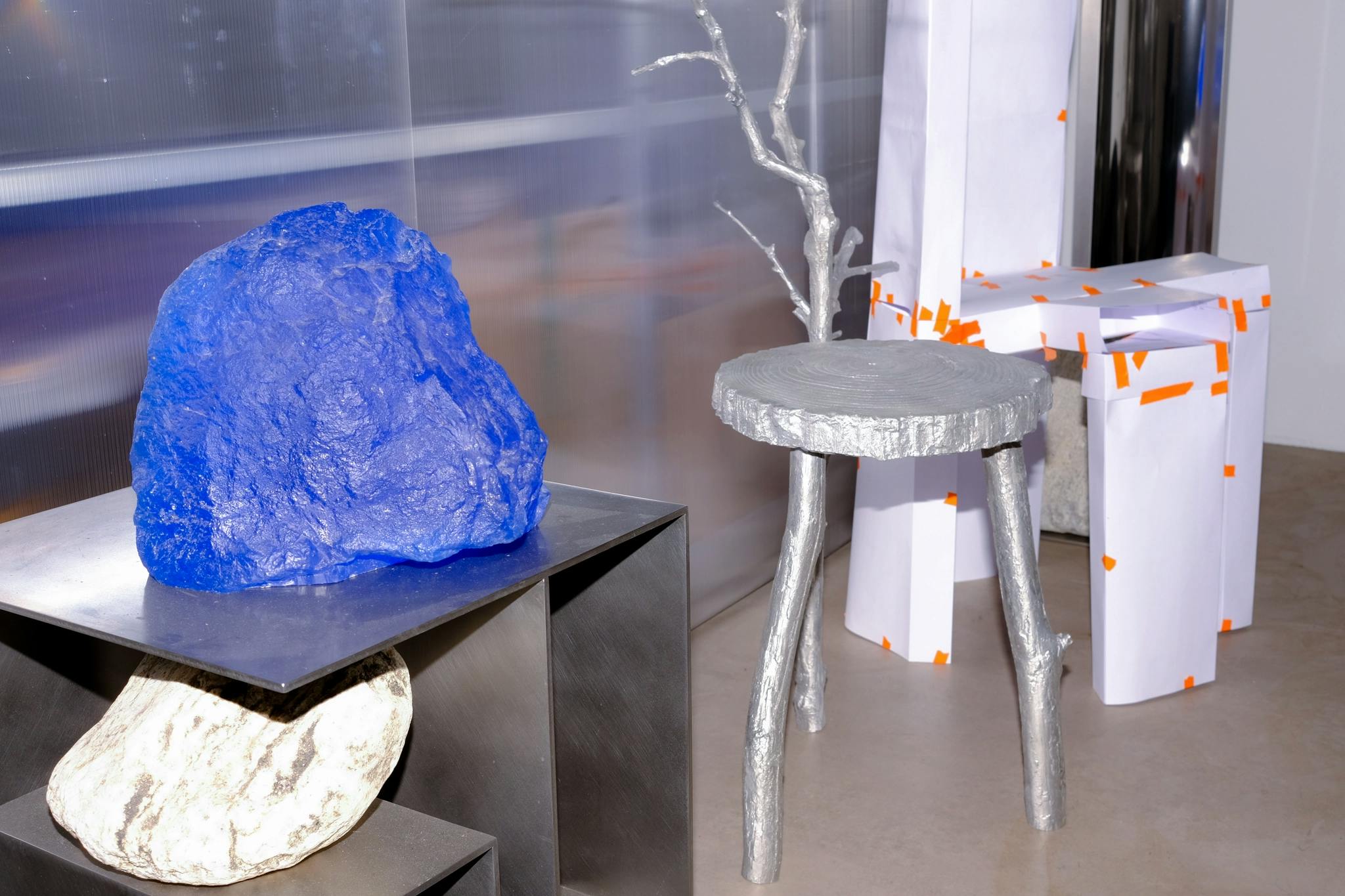
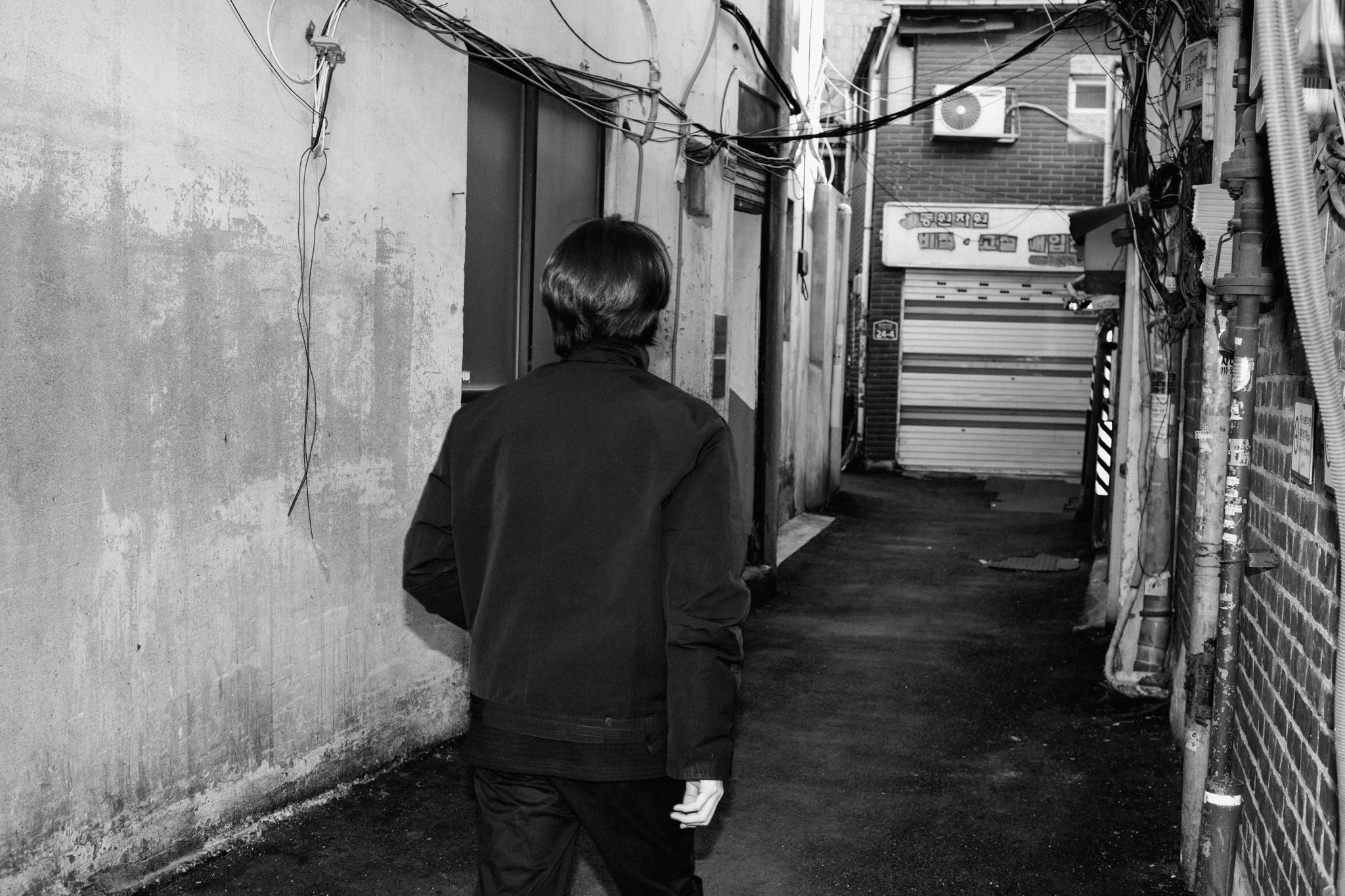
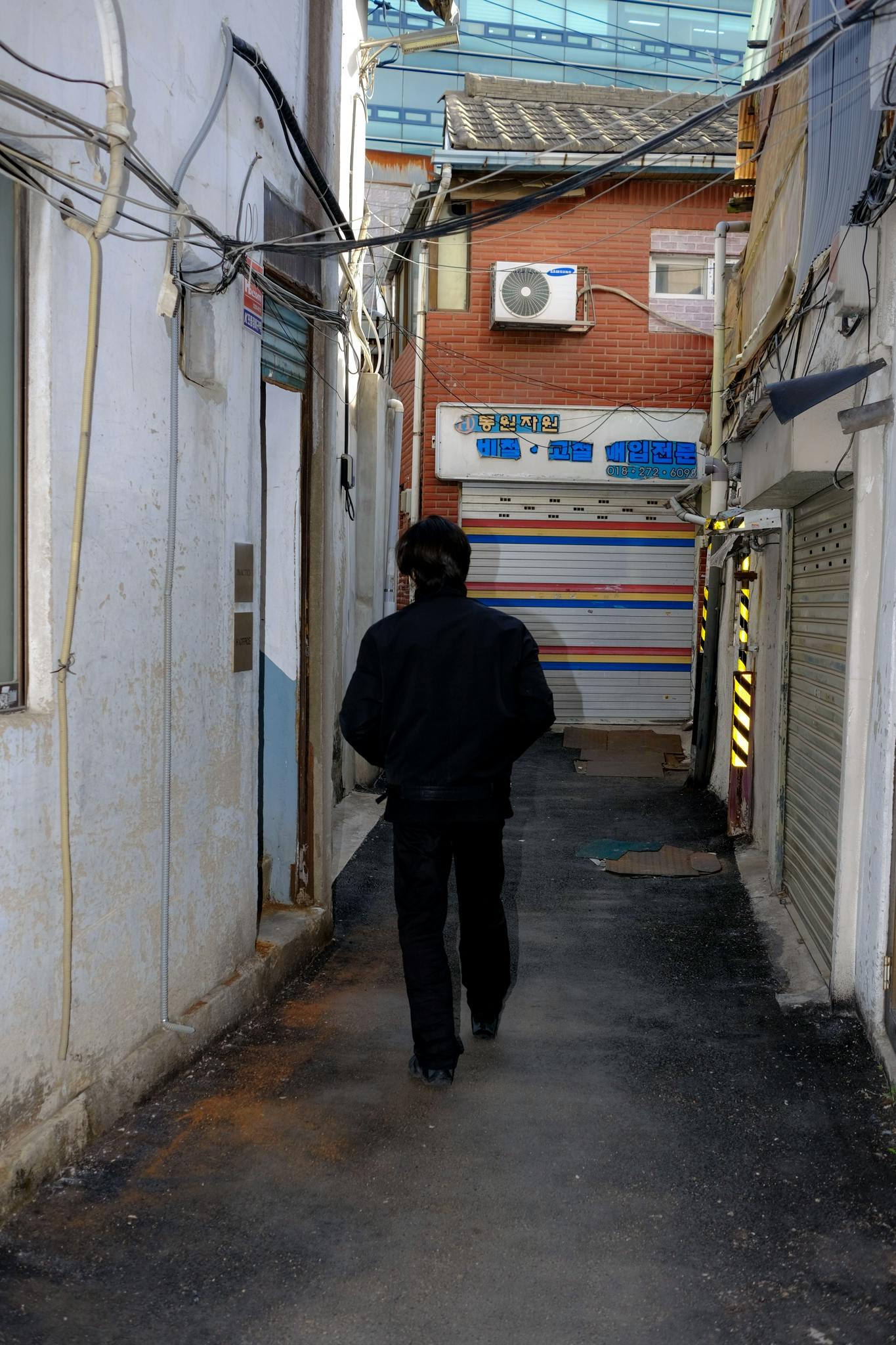

How would you describe contemporary Korean design?
Seohu_ I think this applies to any area like architecture, furniture, and fine art. There’s always a certain current and paradigm for each time period. If you can catch up with those current, you’ll leave your name in history and if you don’t, you won’t.
I feel Korean designers are good at catching up with those paradigms and knowing what is happening right now. To put it in a bad way some people might say they are just following trends. But I think Korean people are good at reading the current.
I agree and think that there is a paradigm. Each century has its ego and its style, for example, Bauhaus or Gothic something like that. I think if I define this, I’m not a historian, I'm not sure how to define Contemporary Art, but there's something. And I think Korean designers read these things quickly.
Anyways I think they read the changes really well and adapted to them. They know what this time period wants and this scene wants.
제 생각에는 모든 분야가 마찬가지인데 건축도 그렇고 가구도 그렇고 파인아트도 그렇고 그 시대의 흐름이 있잖아요. 항상 그때의 패러다임이 있고 그리고 그 흐름을 잘 따라서 가면은 역사 속에 남는 거고 그렇지 못하면 도태되고. 근데 제가 느끼는 한국 디자이너들은 지금 어떻게 흘러가고 있는지를 조금 빨리 파악하는 것 같고, 워낙 인터넷도 다 잘 쓰고 하니까 그러다 보면 좋은 디자인도 제가 느낄 때는 되게 많이 나오는 것 같거든요. 그런 것들 잘 캐치 하는, 나쁘게 말하면 그냥 유행에 편승한다고 말하는 사람들도 있을 것 같아요. 근데 제가 느낄 때는 잘 읽는 편인 것 같, 좀 변화에 적응을 빨리 하고 그 시대가 원하고 그리고 이 신에서 원하는 그런 것들 빨리빨리 잘 찾아가는 것 같아요.
Sisan_ We have a saying, Koreans are very “Ppalli Ppalli (Quickly quickly)”.
I didn’t have much time because Rimowa’s pieces didn’t arrive in time, so I didn't have much time to make them. I had images in my mind, but I only had three days to finish everything perfectly, so I had to be Ppalli ppalli.
I think not only are we very Ppalli Ppalli, but also we have very different cultural characteristics to other countries, which is that we don't have something we can call “Korean style”. We have always been affected by other cultures, such as the colonial period and then the country developed so fast.
In Europe, for example, their architecture is hundreds of years old as it is hard to build new buildings by law, whereas here in Korea, everything changes really fast. Maybe our history made us not have our own identity, but it’s also good in terms of we accept things fast and also read the trend well as Seohu said. But I think people still know what is good, which is why we have lots of different talented artists in such a short period.
한국에 빨리빨리라는 말이 있어요.
리모와 협업을 할때 시간이 많이 부족했죠. 리모와 부품이 와야 되는데 안와서 만들 시간이 없는거에요. 구상은 다 해놨는데. 그렇지만 3일 안에는 완벽한 작품을 만들어야 되니까 빨리빨리 만들어서 전시를 했죠.
한국이 어떻게 컨템퍼러리하게 잘 하고 있냐는 질문에도 저는 빨리 빨리 문화가 있다고 생각해요. 한국은 역사가 뭔가 고유한 게 없었잖아요. 일제 강점기도 있고, 또 급격하게 산업이 발전해서도 있고, 그래서 다른 나라랑 뭔가 좀 다른 문화적인 특징을 가지고 있는 것 같아요.
예를 들어 제가 유럽을 갔을 때, 건축행위도 함부로 할 수 없어서 몇 백 년 전에 지어진 건물이 그대로 남아 볼 수 있는데, 우리나라는 너무 많은 것들이 순식간에 바뀌어 버리 잖아요. 그래서 정체성이 없는 역사도 있지만 거기에 빨리 순응하는 어떤 장점도 있는 것 같고, 그리고 또 아까 말씀대로 잘 캐치하는 것도 있는 것 같고. 근데 좋은 게 뭔지는 알고 만드는 것 같거든요. 그래서 단기간에 좋은, 다양한 작가들이 나오는 것 같아요.
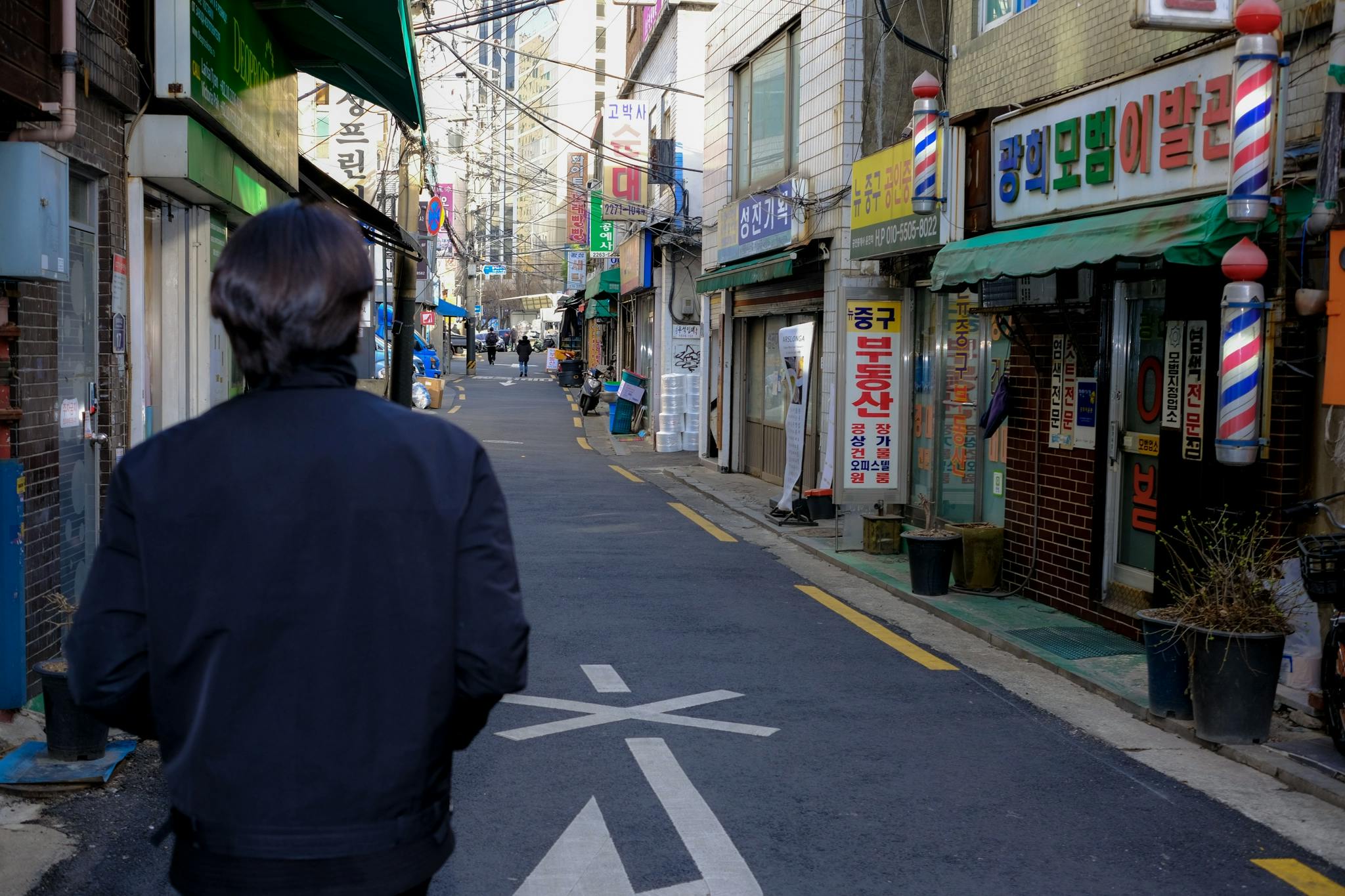
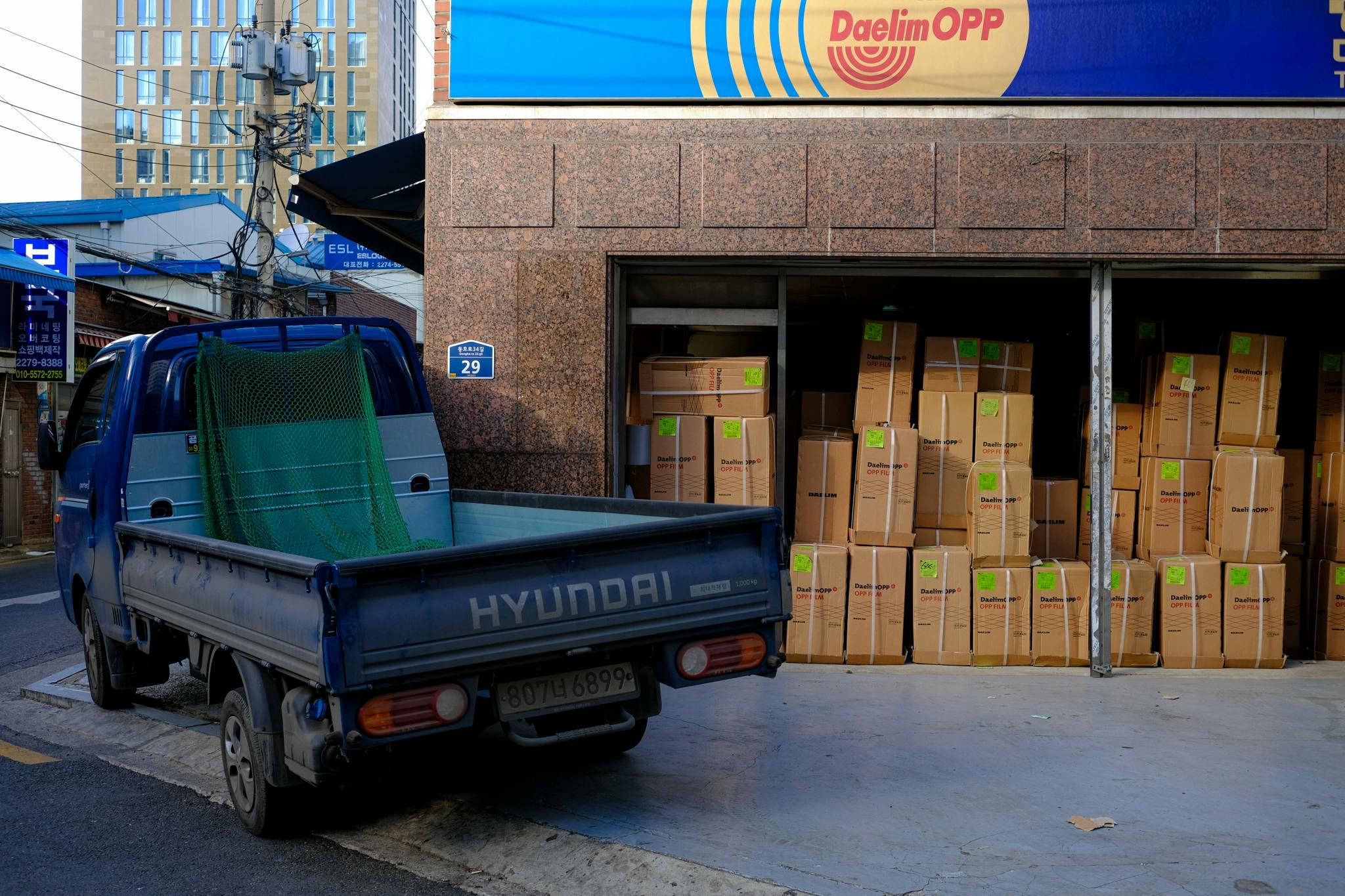
Sisan_ There are many opportunities to experience the changes and also for young artists or architects to practice their work. When I met some architects abroad, they were quite older than us, and it took years to get permission to build something. I think there are certainly a lot more chances to build or make something.
변화를 경험할 수 있는 기회가 많이 있고, 또 젊은 작가들이나 그런 사람 건축가에게도 변화를 만들어갈 기회가 많은 것 같아요. 해외의 건축가를 만나보니 다 나이가 많으시고, 그걸 하려면 몇년에 걸쳐 허가를 받아야 한대요. 근데 한국은 할 수 있는 기회는 확실히 많은 것 같아요.
From the outside looking in, it really resonates with what you said — that the since maybe you don't think that the style is fully defined, I feel that there is a new identity developing. It must be really exciting because it's your generation that kind of gets to decide what that new identity looks like. A bit like how the modernists redefined their style in Europe at the turn of the 20th century.
Sisan_ I was really surprised when I visited the Rimowa exhibition. Lots of different countries participated, but there were lots of Korean designers. Eight or nine people in the exhibition were Korean. It is really surprised me because we are a small country, but we had a lot of designers participating.
리모와 전시에 갔었을때 정말 놀랐었어요. 다양한 나라에서 참여를 하셨는데 한국인 디자이너가 여덟, 아홉명 정도로 정말 많더라구요. 이렇게 작은나라에서 그렇게 많이 참여를 한다는게 놀라웠어요.
I'm not surprised! In my humble opinion, it is because the most exciting things in the world are happening here in Seoul right now. I'm not bullshitting you; it's true! That's why I keep coming back all time.
